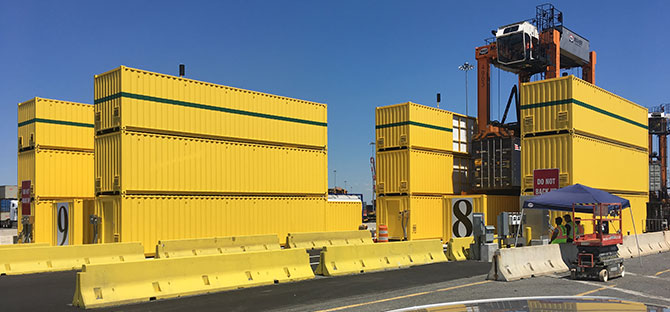Black Friday and Cyber Monday have come and gone, as another holiday season passes. This year may have felt a little bit more intense, given that Thanksgiving happened on the latest day possible in the calendar year. The Port of New York and New Jersey
is humming along like a fine-tuned machine with another record set for the volume of containers handled in the month of October. In the last year, the port’s total container volume jumped from the third highest in the U.S. to second behind Los
Angeles. This is the result of many things, but today, given the subject of this blog, the focus is on “things we take for granted,” which ties into the holiday season and follows up on a project we recently participated in at Maher Terminals
in Elizabeth, New Jersey, as the engineer of record.
Getting to Know Port Terminology
Maher operates one of the world’s largest multi-user container terminals. The highly efficient container terminal operation is located within the Port of New York and New Jersey, which is the gateway to one of the most concentrated consumer markets
in the world and the busiest container port on the east coast of the U.S.
Most imported goods that eventually end up in malls or delivered to your doorstep in Amazon boxes are shipped thousands of miles in intermodal containers on huge ocean-going vessels that are capable of handling upwards of 14,000 containers or TEUs. Containers
are mostly 20 or 40 feet long, and the container volumes are measured in “twenty-foot equivalent units,” thus TEUs. Containers are discharged by enormous ship-to-shore cranes into container terminals and then transferred to trucks or trains
for distribution across the U.S.
Today’s modern container terminals can vary in levels of automation, but all employ specialized computer systems that utilize geospatial information systems (GIS) and artificial intelligence (AI) to maximize operational efficiency and reduce the
time it takes to process and move containers off the terminal. At Maher Terminal, straddle carriers are used to transport containers from the ships to nearby trains for cross-country delivery. A straddle carrier is a large, fast moving, eight-wheeled
piece of equipment—like something out of a Star Wars movie—that carries containers without the need for a truck chassis. In effect, a straddle carrier “straddles” over the container and picks it up for transport within the
container terminal.
National Security
Not too long after September 11, 2001, all imported containers were required to be scanned for the presence of radioactive material before leaving the port. Manual individual searches of the literally tens of thousands of containers imported into the
U.S. on a daily basis are simply not feasible, so the Department of Homeland Security (DHS)—partnering with other intelligence agencies, shippers, and terminal operators—developed Radiation Portal Monitors (RPMs) that are capable of quickly
scanning containers for the presence of radioactive material when they leave the port facilities by truck.
Creating an Efficient Process
Until recently, there wasn’t a similarly seamless process for scanning containers transferred by straddle carriers to be loaded onto trains. Traditional RPMs are unable to scan containers being moved by a straddle carrier due to the size and design
of the equipment. All containers being transferred to rail cars needed to be staged in an area on the terminal so they could be manually scanned by a mobile RPM unit. This created inefficiencies, such as double handling and loss of precious terminal
space to allow for container scanning.

The newly installed straddle carrier RPM scanning system at Maher Terminal has vastly improved the flow and efficiency of the shipment of imported containers from vessel to train, while also freeing up operating space on the terminal.
This successful modification of a relatively new technology onto an existing straddle carrier operating system helped achieve the secure, seamless flow of containerized goods in time for the holidays. Security and convenience of consumer goods—things
we take for granted.